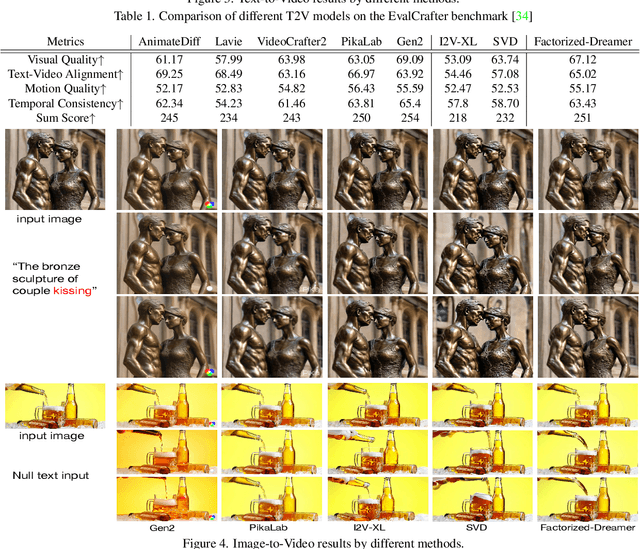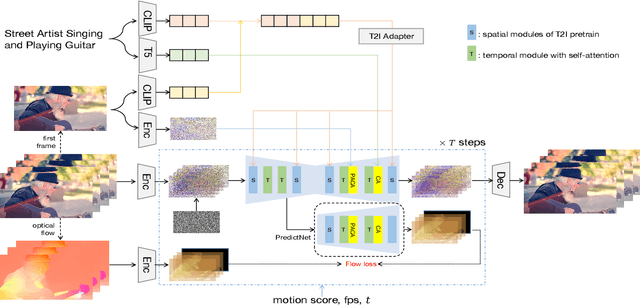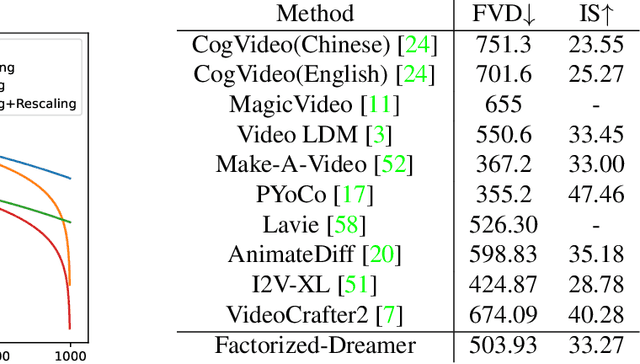Yunwen Huang
Factorized-Dreamer: Training A High-Quality Video Generator with Limited and Low-Quality Data
Aug 19, 2024



Abstract:Text-to-video (T2V) generation has gained significant attention due to its wide applications to video generation, editing, enhancement and translation, \etc. However, high-quality (HQ) video synthesis is extremely challenging because of the diverse and complex motions existed in real world. Most existing works struggle to address this problem by collecting large-scale HQ videos, which are inaccessible to the community. In this work, we show that publicly available limited and low-quality (LQ) data are sufficient to train a HQ video generator without recaptioning or finetuning. We factorize the whole T2V generation process into two steps: generating an image conditioned on a highly descriptive caption, and synthesizing the video conditioned on the generated image and a concise caption of motion details. Specifically, we present \emph{Factorized-Dreamer}, a factorized spatiotemporal framework with several critical designs for T2V generation, including an adapter to combine text and image embeddings, a pixel-aware cross attention module to capture pixel-level image information, a T5 text encoder to better understand motion description, and a PredictNet to supervise optical flows. We further present a noise schedule, which plays a key role in ensuring the quality and stability of video generation. Our model lowers the requirements in detailed captions and HQ videos, and can be directly trained on limited LQ datasets with noisy and brief captions such as WebVid-10M, largely alleviating the cost to collect large-scale HQ video-text pairs. Extensive experiments in a variety of T2V and image-to-video generation tasks demonstrate the effectiveness of our proposed Factorized-Dreamer. Our source codes are available at \url{https://github.com/yangxy/Factorized-Dreamer/}.
Breast Lesion Diagnosis Using Static Images and Dynamic Video
Aug 19, 2023



Abstract:Deep learning based Computer Aided Diagnosis (CAD) systems have been developed to treat breast ultrasound. Most of them focus on a single ultrasound imaging modality, either using representative static images or the dynamic video of a real-time scan. In fact, these two image modalities are complementary for lesion diagnosis. Dynamic videos provide detailed three-dimensional information about the lesion, while static images capture the typical sections of the lesion. In this work, we propose a multi-modality breast tumor diagnosis model to imitate the diagnosing process of radiologists, which learns the features of both static images and dynamic video and explores the potential relationship between the two modalities. Considering that static images are carefully selected by professional radiologists, we propose to aggregate dynamic video features under the guidance of domain knowledge from static images before fusing multi-modality features. Our work is validated on a breast ultrasound dataset composed of 897 sets of ultrasound images and videos. Experimental results show that our model boosts the performance of Benign/Malignant classification, achieving 90.0% in AUC and 81.7% in accuracy.
 Add to Chrome
Add to Chrome Add to Firefox
Add to Firefox Add to Edge
Add to Edge